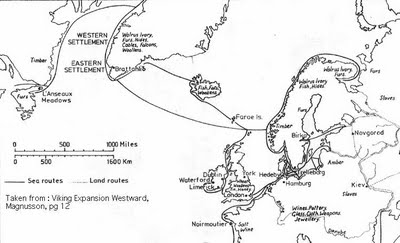After DATE, the next most important consideration in characterization may be PLACE.
The physical location for a character creates a framework that determines what they could know, what they might do, how they might look, and what objects they might have available to them. A town dweller in the home country is sure to be quite different than a farmer in a colony. For most historic periods, the stress should be placed on locally available resources. A good example of this can be found in building construction, where rough form may be cultural, but local materials determine the actual details. This is not always the case, as cultural factors might prevent local materials from being adopted. A nice example here would be early Canadian English freezing to death in cloth coats, because wearing Native style furs was 'just not British'. Access to imported goods has always been restricted, usually thus expensive. What might be easily available in a local area may become high status luxury in a distant place.
The re-
enactor is always constrained by the mechanisms of artifact preservation and recovery, a topic that will be dealt with separately. Even when hoping to keep centered to a specific location, lack of artifact prototypes may force you to expand your circle.
As a direct application to
DARC at
Vinland, take a look at this map of the Norse North Atlantic:

The general immigration patterns during the Viking Age are this:
Danes to England
Swedes to Russia
Norwegians to the North AtlanticSo concentrating on the Norwegians the general pattern is:
Norway to the Shetlands and Scotland
Norway to Ireland (but there are plenty of Danes there too!)
Norse Scotland and Norway to the
FaeroesNorse Ireland and Norway to Iceland
Iceland to Greenland
Greenland and Iceland to
VinlandThe pattern is clearly a series of individual stepping stones, both as they moved westward, and as time progressed.
Using our determined time line at 1000 AD, within a normal life time, the primary focus for our characterizations should be Iceland. It is possible to expand slightly to Norway, Norse Scotland and Ireland.
Iceland as a focus presents special problems in terms of artifact selection. Although not marginal, it still had limited resources in terms of raw materials. There will be a considerable impact on the
availability and quality of many 'commercial' goods, which primarily had to be imported from the outside. This overall tends to push objects upwards in status level.
Darrell
Author's Note: This part of a series of shorter descriptions that will add together to paint a picture of the background to DARC's upcoming presentation at L'Anse aux Meadows NHSC in August of 2010. Taken together, these articles will deal with a number of specific interpretive elements, using Vinland in the Viking Age as the concrete example. These are most likely to presented here very much in a random order. Hope is to tie them together into a coherent package to be delivered at Forward Into the Past in late March.Labels: historic intepretation, L'Anse aux Meadows






















